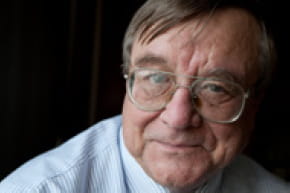Discovering the Source
Long ago, early explorers searched for the sources of the world’s great rivers, often through great adversity. “Discovering the source” became a life’s work for some of these explorer-discovers. In this year’s Annual Report, we focus on our research that strives to “discover the sources” of disorders and diseases. We showcase our exploration of the underlying mechanisms and fundamental processes occurring during the earliest stages of development that later adversely impact children’s and adults’ health. We highlight this work of discovery because understanding such mechanisms is essential to developing the early interventions or therapies that will prevent or obviate adverse outcomes and alter the developmental origins of pediatric and adult disease.
Today, we work to repair congenital defects and cure children whose health problems began before birth or early in life. We ask, “What basic mechanisms cause these problems?” with the goal of “discovering the source.” How can we treat these developmental origins of disease? Even better, how can we prevent or mitigate these adverse fetal and infantile events? These are the questions that fuel the daily work of our research teams. In this Report, you will learn about researchers who explore the timing and quality of the embryo’s uterine implantation and its potential impact on infertility and prematurity. You will read about how advances in assisted reproduction, although bringing the joys of parenthood to many, also raise important questions about the long-term health of the children born as a result. We highlight an effort to determine the molecular origins of craniofacial deformities. This is just one of many collaborations between our developmental biologists who study organogenesis and stem cell biology and clinicians who treat and surgically repair congenital anomalies. In other examples, you will discover how our developmental neuroscientists are exploring early brain formation. They seek to understand how the amygdala, a part of the forebrain that controls the fear response, originates and how abnormalities in this and in brain white matter formation lead to neurological and behavioral deficits and disabilities. And finally, you will meet a cardiologist whose research led her to develop a breakthrough imaging technique for children at risk of heart and vascular disease with the goal of developing timely interventions to prevent long-term damage. These stories feature our collaborative research environment, the interactions of clinicians and scientists, that are a keystone of our approach to “discovering the source.”
You will also learn, through Divisional summaries and the statistical data at the end of this Annual Report, of the innovative clinical care and the extraordinary educational accomplishments achieved in 2011.
To continue “discovering the source,” our Cincinnati Children’s Research Foundation (CCRF) Strategic Plan emphasizes future development along themes of Innovative Therapeutics and Diagnostics, including Medicinal Chemistry; Regenerative Medicine, Stem Cell Biology and Organogenesis; Inflammation and Immunity; Environment-Phenome-Genome Interactions in Health and Disease; Protein Sciences and Structural Biology; Health Services, Outcomes and Quality and Systems Improvement; Genomics and Epigenomics; and Bioinformatics and Systems Biology. These themes will be supported by an expanded infrastructure of cores, epidemiology and biostatistics, and data management to expand multi-site and multi-disciplinary patient-related studies.
I am continually impressed and inspired by the depth, breadth and quality of our clinical care, education and research accomplishments. This summary of our 2011 achievements, with more detail on the CCRF website, demonstrates why Cincinnati Children’s is the leader in academic pediatric medicine. We invite you to explore CCRF, share our sense of excitement in the discoveries of our extraordinarily talented investigators, clinicians and educators, and to learn how we, like those early explorers, are “discovering the source” to improve child health.




